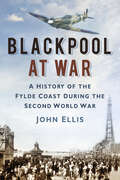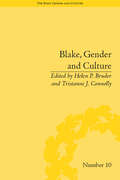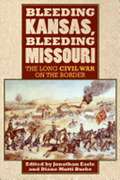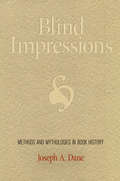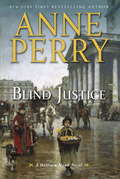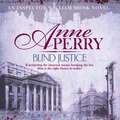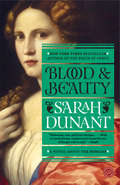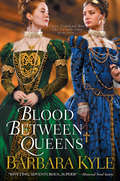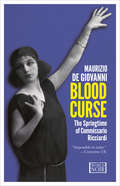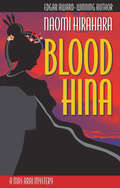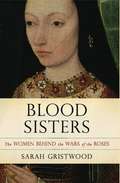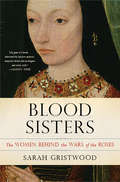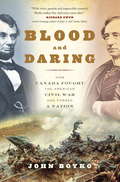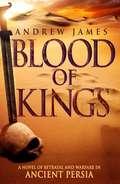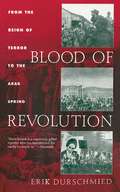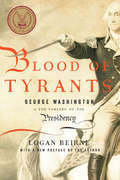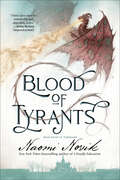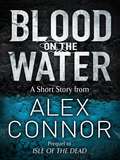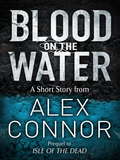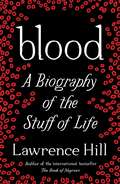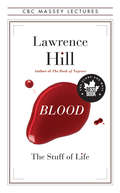- Table View
- List View
Blackpool at War: A History of the Fylde Coast during the Second World War
by John EllisAlthough it escaped bombing raids, Blackpool played an important role in the Second World War as a centre for training — with numerous airfields and factories surrounding the area. This book is the first to offer a dedicated history of the town in the period. It includes many interesting stories such as the people’s playground, the Freckleton Air Disaster and an event-by-event account of activities. Despite being less affected than some other areas, the difficult war years still impacted on local people. Filled with true tales of local courage and of the spirit of the people of Blackpool during these tumultuous years, this nostalgic volume will be of interest to all who know and love Blackpool.
Blacks In and Out of the Left
by Michael C. DawsonThe radical black left that played a crucial role in twentieth-century struggles for equality and justice has largely disappeared. Michael Dawson investigates the causes and consequences of the decline of black radicalism as a force in American politics and argues that the conventional left has failed to take race sufficiently seriously as a historical force in reshaping American institutions, politics, and civil society. African Americans have been in the vanguard of progressive social movements throughout American history, but they have been written out of many histories of social liberalism. Focusing on the 1920s and 1930s, as well as the Black Power movement, Dawson examines successive failures of socialists and Marxists to enlist sympathetic blacks, and white leftistsâe(tm) refusal to fight for the cause of racial equality. Angered by the often outright hostility of the Socialist Party and similar social democratic organizations, black leftists separated themselves from these groups and either turned to the hard left or stayed independent. A generation later, the same phenomenon helped fueled the Black Power movementâe(tm)s turn toward a variety of black nationalist, Maoist, and other radical political groups. The 2008 election of Barack Obama notwithstanding, many African Americans still believe they will not realize the fruits of American prosperity any time soon. This pervasive discontent, Dawson suggests, must be mobilized within the black community into active opposition to the social and economic status quo. Black politics needs to find its way back to its radical roots as a vital component of new American progressive movements.
Blake, Gender and Culture ("The Body, Gender and Culture" #10)
by Helen P BruderBlake's combination of verse and design invites interdisciplinary study. The essays in this collection approach his work from a variety of perspectives including masculinity, performance, plant biology, empire, politics and sexuality.
Bleeding Kansas, Bleeding Missouri: The Long Civil War On the Border
by Jonathan Earle Diane Mutti BurkeLong before the first shot of the Civil War was fired at Fort Sumter, violence had already erupted along the Missouri-Kansas border—a recurring cycle of robbery, arson, torture, murder, and revenge. This multifaceted study brings together fifteen scholars to expand our understanding of this vitally important region, the violence that besieged it, and its overall impact on the Civil War. <p><p> Bleeding Kansas, Bleeding Missouri blends political, military, social, and intellectual history to explain why the region's divisiveness was so bitter and persisted for so long. Providing a more nuanced understanding of the conflict, it defines both what united and divided the men and women who lived there and how various political disagreements ultimately disintegrated into violence. By focusing on contested definitions of liberty, citizenship, and freedom, it also explores how civil societies break down and how they are reconstructed when the conflict ends. <p><p> The contributors examine this key chapter in American history in all of its complexity. Essays on "Slavery and Politics of Law and Order along the Border" examine how the border region was transformed by the conflict over the status of slavery in Kansas Territory and how the emerging conflict on the Kansas-Missouri border took on a larger national significance. Other essays focus on the transition to total warfare and examine the wartime experiences of the diverse people who populated the region in "Making the Border Bleed." Final articles on "The Border Reconstructed and Remembered" explore the ways in which border residents rebuilt their society after the war and how they remembered it decades later. <p><p> As this penetrating collection shows, only when Missourians and Kansans embraced a common vision for America—one based on shared agricultural practices, ideas about economic development, and racial equality—could citizens on both sides of the border reconcile.
Blind Impressions
by Joseph A. DaneWhat is a book in the study of print culture? For the scholar of material texts, it is not only a singular copy carrying the unique traces of printing and preservation efforts, or an edition, repeated and repeatable, or a vehicle for ideas to be abstracted from the physical copy. But when the bibliographer situates a book copy within the methods of book history, Joseph A. Dane contends, it is the known set of assumptions which govern the discipline that bibliographic arguments privilege, repeat, or challenge. "Book history," he writes, "is us."In Blind Impressions, Dane reexamines the field of material book history by questioning its most basic assumptions and definitions. How is print defined? What are the limits of printing history? What constitutes evidence? His concluding section takes form as a series of short studies in theme and variation, considering such matters as two-color printing, the composing stick used by hand-press printers, the bibliographical status of book fragments, and the function of scholarly illustration in the Digital Age. Meticulously detailed, deeply learned, and often contrarian, Blind Impressions is a bracing critique of the way scholars define and solve problems.
Blind Justice
by Anne PerryFor a generation, Anne Perry's New York Times bestselling novels have invited readers to explore the brilliantly seductive heart of Victorian London, where great wealth and great evil live side by side, and great men sometimes make unfortunate choices. In Perry's stunning new novel, Hester Monk, the wife of William Monk, commander of the Thames River Police, questions the finances of a London church whose members' hard-earned charitable gifts appear to have ended up in the pocket of charismatic preacher Abel Taft, paying for his fine home and the stylish outfits of his wife and daughters. Taft is accused of extortion, and brilliant barrister Oliver Rathbone, newly appointed a judge, is chosen to preside over his trial. It seems clear that Taft is indeed guilty. However, at the last second, the defense produces a witness who completely undermines the charges. Then Rathbone makes a well-meaning but reckless move that could ruin his career, his reputation, and his life. Blind Justice presents a rich and lively panorama of London life, from the teeming Thames docks to the wealthy West End, while unfolding a magnificent courtroom drama. And while justice, law, and morality hang in the balance, Hester and Monk race to save their distinguished friend Rathbone from disgrace. The incomparable art of Anne Perry grips us fast until the final, unforgettable scene. PRAISE FOR ANNE PERRY AND HER WILLIAM MONK NOVELS A Sunless Sea "Anne Perry's Victorian mysteries are marvels."--The New York Times Book Review Acceptable Loss "Masterful storytelling and moving dialogue."--The Star-Ledger Execution Dock "[An] engrossing page-turner . . . There's no one better at using words to paint a scene and then fill it with sounds and smells than Anne Perry."--The Boston Globe Dark Assassin "Brilliant . . . a page-turning thriller . . . blending compelling plotting with superbly realized human emotion and exquisite period detail."--Jeffery Deaver, author of Edge The Shifting Tide "The mysterious and dangerous waterfront world of London's 'longest street,' the Thames, comes to life."--South Florida Sun-SentinelFrom the Hardcover edition.
Blind Justice: A dangerous hunt for justice in a thrilling Victorian mystery (William Monk Mystery #19)
by Anne PerryIf protecting the innocent means breaking the law, what is the right choice to make? Inspector William Monk searches for the elusive truth in a controversial and dangerous case in Blind Justice, the nineteenth novel in Anne Perry's acclaimed series. Perfect for fans of C. J. Sansom and Arthur Conan Doyle.'A staggering achievement... Perry's command of plot and prose shines' - BookreporterOliver Rathbone, William Monk's close friend, has presided brilliantly over his first cases as a judge. But the next will bring a far greater challenge. Abel Taft, a charismatic minister adored by his congregation, stands accused of terrible corruption and fraud which has ruined the lives of those he's betrayed.In court, each victim affirms Taft's guilt, but when the defence's star witness tears their stories apart, the case seems lost. Rathbone realises he holds, locked away, a piece of evidence that could change the outcome of the trial and bring true justice, but can he, as the judge, become involved? The decision Rathbone makes will draw Monk deep into a dangerous case that will shape the rest of both their lives...Winner of the Killer Nashville Silver Falchion Award for Best Historical Novel 2014. What readers are saying about Blind Justice: 'I have found Anne Perry to be one of the best writers I have read. Her books are very atmospheric and I feel that I am actually in Victorian London''A riveting mystery wrapped up in the dark and seedy side of Victorian London''Anne Perry is the best Victorian crime [writer] I have ever read'
Blind Justice: A dangerous hunt for justice in a thrilling Victorian mystery (William Monk Mystery #19)
by Anne PerryAnne Perry's Inspector William Monk: in search of justice, he will not stop until he has found the truth...Oliver Rathbone, William Monk's close friend, has presided brilliantly over his first cases as a judge. But the next will bring a far greater challenge. Abel Taft, a charismatic minister adored by his congregation, stands accused of terrible corruption and fraud which has ruined the lives of those he's betrayed.In court, each victim affirms Taft's guilt, but when the defence's star witness tears their stories apart, the case seems lost. Rathbone realises he holds, locked away, a piece of evidence that could change the outcome of the trial and bring true justice, but can he, as the judge, become involved? The decision Rathbone makes will draw Monk deep into a dangerous case that will shape the rest of both their lives...(P)2013 Headline Digital
Blood & Beauty
by Sarah DunantThe New York Times bestselling author of the acclaimed Italian Renaissance novels--The Birth of Venus, In the Company of the Courtesan, and Sacred Hearts--has an exceptional talent for breathing life into history. Now Sarah Dunant turns her discerning eye to one of the world's most intriguing and infamous families--the Borgias--in an engrossing work of literary fiction. By the end of the fifteenth century, the beauty and creativity of Italy is matched by its brutality and corruption, nowhere more than in Rome and inside the Church. When Cardinal Rodrigo Borgia buys his way into the papacy as Alexander VI, he is defined not just by his wealth or his passionate love for his illegitimate children, but by his blood: He is a Spanish Pope in a city run by Italians. If the Borgias are to triumph, this charismatic, consummate politician with a huge appetite for life, women, and power must use papacy and family--in particular, his eldest son, Cesare, and his daughter Lucrezia--in order to succeed. Cesare, with a dazzlingly cold intelligence and an even colder soul, is his greatest--though increasingly unstable--weapon. Later immortalized in Machiavelli's The Prince, he provides the energy and the muscle. Lucrezia, beloved by both men, is the prime dynastic tool. Twelve years old when the novel opens, hers is a journey through three marriages, and from childish innocence to painful experience, from pawn to political player. Stripping away the myths around the Borgias, Blood & Beauty is a majestic novel that breathes life into this astonishing family and celebrates the raw power of history itself: compelling, complex and relentless.
Blood Between Queens (Thornleigh Saga #5)
by Barbara KyleFollowing her perilous fall from a throne she'd scarcely owned to begin with, Mary, Queen of Scots, has fled to England, hoping her cousin, Queen Elizabeth, will grant her asylum. But now Mary has her sights on the English crown, and Elizabeth enlists her most trusted subjects to protect it. Justine Thornleigh is delighting in the thrill of Queen Elizabeth's visit to her family's estate when the festivities are cut short by Mary's arrival. To Justine's surprise, the Thornleighs appoint her to serve as a spy in Mary's court. But bearing the guise of a lady-in-waiting is not Justine's only secret. The weight of her task is doubled by fears of revealing to her fiancé that she is in truth the daughter of his family's greatest rival. Duty-bound, Justine must sacrifice love as she navigates a deadly labyrinth of betrayal that could lead to the end of Elizabeth's fledgling reign. . .Compelling and inventive, Blood Between Queens artfully blends history's most intriguing figures with unforgettable characters, bringing to dazzling life the fascinating Tudor era.
Blood Curse: The Springtime of Commissario Ricciardi (The Commissario Ricciardi Mysteries #2)
by Maurizio de GiovanniThe second historical mystery featuring Commissario Ricciardi, “one of the most interesting and well-drawn detectives in fiction” (The Daily Beast).Commissario Ricciardi has visions. He sees and hears the final seconds in the lives of victims of violent deaths. It is both a gift and a curse. It has helped him become one of the most acute and successful homicide detectives in the Naples police force. But all that horror and suffering has hollowed him out emotionally. He drinks and doesn’t sleep. Other than his loyal partner, Brigadier Maione, he has no friends.Naples, 1931. In a working-class apartment in the Sanità neighborhood, an elderly woman by the name of Carmela Calise has been beaten to death. When Ricciardi and Maione arrive at the scene, they learn that Calise was moonlighting as a fortuneteller and moneylender whose clients were some of the city’s rich and powerful. She predicted their futures in such a way as to manipulate and deceive and made many enemies—those indebted to her, swayed by her lies, disappointed by her prophesies or destroyed by her machinations. Murder suspects in this atmospheric thriller abound and Commissario Ricciardi, one of the most original and intriguing investigators in contemporary crime fiction, will have his work cut out for him.“The promise that each life will intersect keeps Ricciardi and Maione’s investigation lively.” —Publishers Weekly“A well-crafted, ultimately moving crime novel set in 1931 Naples . . . This is a solid series with an intriguing detective, and fans will eagerly await the third volume.” —Library Journal
Blood Hina: A Mas Arai Mystsery (The Mas Arai Mysteries #4)
by Naomi HiraharaMas Arai's best friend Haruo is getting married, and he has grudgingly agreed to serve as best man. But when an ancient Japanese doll display of Haruo's fiancée goes missing, the wedding is called off with fingers pointed at Haruo. To solve the mystery to save Haruo's life, Mas must untangle a web of secrecy, heart-breaking memories, and murder.
Blood Sisters
by Sarah GristwoodTo contemporaries, the Wars of the Roses were known collectively as a "cousins' war." The series of dynastic conflicts that tore apart the ruling Plantagenet family in fifteenth-century England was truly a domestic drama, as fraught and intimate as any family feud before or since.As acclaimed historian Sarah Gristwood reveals in Blood Sisters, while the events of this turbulent time are usually described in terms of the male leads who fought and died seeking the throne, a handful of powerful women would prove just as decisive as their kinfolks' clashing armies. These mothers, wives, and daughters were locked in a web of loyalty and betrayal that would ultimately change the course of English history. In a captivating, multigenerational narrative, Gristwood traces the rise and rule of the seven most critical women in the wars: from Marguerite of Anjou, wife of the Lancastrian Henry VI, who steered the kingdom in her insane husband's stead; to Cecily Neville, matriarch of the rival Yorkist clan, whose son Edward IV murdered his own brother to maintain power; to Margaret Beaufort, who gave up her own claim to the throne in favor of her son, a man who would become the first of a new line of Tudor kings.A richly drawn, absorbing epic, Blood Sisters is a tale of hopeful births alongside bloody deaths, of romance as well as brutal pragmatism. It is a story of how women, and the power that women could wield, helped to end the Wars of the Roses, paving the way for the Tudor age-and the creation of modern England.
Blood Sisters: The Women Behind the Wars of the Roses
by Sarah GristwoodTo contemporaries, the Wars of the Roses were known collectively as a ?cousinsOCO war. OCO The series of dynastic conflicts that tore apart the ruling Plantagenet family in fifteenth-century England was truly a domestic drama, as fraught and intimate as any family feud before or since. As acclaimed historian Sarah Gristwood reveals in "Blood Sisters," while the events of this turbulent time are usually described in terms of the male leads who fought and died seeking the throne, a handful of powerful women would prove just as decisive as their kinfolksOCO clashing armies. These mothers, wives, and daughters were locked in a web of loyalty and betrayal that would ultimately change the course of English history. In a captivating, multigenerational narrative, Gristwood traces the rise and rule of the seven most critical women in the wars: from Marguerite of Anjou, wife of the Lancastrian Henry VI, who steered the kingdom in her insane husbandOCOs stead; to Cecily Neville, matriarch of the rival Yorkist clan, whose son Edward IV murdered his own brother to maintain power; to Margaret Beaufort, who gave up her own claim to the throne in favor of her son, a man who would become the first of a new line of Tudor kings. A richly drawn, absorbing epic, "Blood Sisters" is a tale of hopeful births alongside bloody deaths, of romance as well as brutal pragmatism. It is a story of how women, and the power that women could wield, helped to end the Wars of the Roses, paving the way for the Tudor age?and the creation of modern England. "
Blood Sisters: The Women Behind the Wars of the Roses
by Sarah GristwoodTo contemporaries, the Wars of the Roses were known collectively as a "cousins' war.” The series of dynastic conflicts that tore apart the ruling Plantagenet family in fifteenth-century England was truly a domestic drama, as fraught and intimate as any family feud before or since. As acclaimed historian Sarah Gristwood reveals in Blood Sisters, while the events of this turbulent time are usually described in terms of the male leads who fought and died seeking the throne, a handful of powerful women would prove just as decisive as their kinfolks' clashing armies. These mothers, wives, and daughters were locked in a web of loyalty and betrayal that would ultimately change the course of English history. In a captivating, multigenerational narrative, Gristwood traces the rise and rule of the seven most critical women in the wars: from Marguerite of Anjou, wife of the Lancastrian Henry VI, who steered the kingdom in her insane husband's stead; to Cecily Neville, matriarch of the rival Yorkist clan, whose son Edward IV murdered his own brother to maintain power; to Margaret Beaufort, who gave up her own claim to the throne in favor of her son, a man who would become the first of a new line of Tudor kings.A richly drawn, absorbing epic, Blood Sisters is a tale of hopeful births alongside bloody deaths, of romance as well as brutal pragmatism. It is a story of how women, and the power that women could wield, helped to end the Wars of the Roses, paving the way for the Tudor age-and the creation of modern England.
Blood and Daring
by John BoykoBlood and Daring will change our views not just of Canada's relationship with the United States, but of the Civil War, Confederation and Canada itself. In Blood and Daring, lauded historian John Boyko makes a compelling argument that Confederation occurred when and as it did largely because of the pressures of the Civil War. Many readers will be shocked by Canada's deep connection to the war--Canadians fought in every major battle, supplied arms to the South, and many key Confederate meetings took place on Canadian soil. Boyko gives Americans a new understanding of the North American context of the war, and also shows how the political climate of the time created a more unified Canada, one that was able to successfully oppose American expansion. Filled with engaging stories and astonishing facts from previously unaccessed primary sources, Boyko's fascinating new interpretation of the war will appeal to all readers of history. Blood and Daring will change our views not just of Canada's relationship with the United States, but of Confederation itself.
Blood of Kings
by Andrew JamesPraise for Blood of Kings:'Extremely compelling..... an almost Game of Thrones feel at times. The novel is certainly a page-turner...I look forward to reading a continuation' Ancient Warfare Magazine'This is a brilliantly written and scrupulously researched historical novel that uniquely captures the atmosphere surrounding the rise to power of Darius, the greatest king of Ancient Persia. His story is interwoven with parallel events in Egypt and Greece, making this novel of absorbing interest to anybody with an interest in the ancient world' Dr John Curtis, OBE, FBA, formerly Keeper of the Department of Middle East, the British MuseumIt is 530 BC and Cyrus the Great has carved out the largest Empire the world had ever seen, making Persia the undisputed superpower of the ancient world. But there is treachery afoot, and Cyrus's life is in danger. In a fast paced tale of love, war, betrayal and revenge, Blood of Kings sweeps the reader up on an epic journey from the mud brick cities of Ancient Persia to the burning heart of Pharaoh's Egypt. Packed full of dramatic and authentic battle scenes, it recreates the sweat, blood and fear of ancient warfare, as Persia smashes Egypt's army and brings the reign of the Pharaohs to a violent end. But it is also a book that will delight Herodotus fans, bringing the ancient Greek historian's characters to life like never before, as it follows the doomed 'lost army of Cambyses' into the Libyan Desert, marching towards a fate that would baffle archaeologists for millennia to come. 'You must read Blood of Kings. . . a masterpiece of historical fiction' Dr Bryan Wood, Author'Vivid...original and fascinating' F. Bailey, Scriptwriter for BBC's 'Peak Practice' 'Andrew James has captured the very spirit of the Ancient Achaemenids . . . he literally takes the reader back in time to the Persians of old. I would highly recommend this historical novel . . .' Dr Kaveh Farrokh, Lecturer and Reader of History at the University of British Columbia Continuing Studies Division
Blood of Revolution: From the Reign of Terror to the Arab Spring
by Erik DurschmiedIn this fascinating book, the author of The Hinge Factor and The Weather Factor surveys revolutions across the centuries, vividly portraying the people and events that brought wrenching, often enduring--and always bloody--change to countries and societies almost overnight. Durschmied begins with the French Revolution and goes on to examine the revolutions of Mexico in 1910, Russia in 1917, and Japan in 1945, as well as the failed putsch against Hitler in 1944. His account of the Cuban Revolution is peppered with personal anecdotes--for he was the first foreign correspondent to meet Castro when the future leader was still in the Sierra Maestra. He concludes with the Iranian Revolution that ousted the Shah in 1979--another that he personally covered--and, in a new preface, extends his analysis to the Arab Spring.Each revolution, Durschmied contends, has its own dynamic and memorable cast of characters, but all too often the end result is the same: mayhem, betrayal, glory, and death. Unlike the American Revolution, which is the counterexample, few revolutions are spared the harsh reality that most devour their own children."Durschmied is a supremely gifted reporter who has transformed the media he works in."--Newsweek"[A] light and lively narrative that serves as a useful introduction for the general reader."--Library Journal
Blood of Tyrants
by Logan BeirneBlood of Tyrants reveals the surprising details of our Founding Fathers' approach to government and this history's impact on today. Delving into the forgotten-and often lurid-facts of the Revolutionary War, Logan Beirne focuses on the nation's first commander in chief, George Washington, as he shaped the very meaning of the United States Constitution in the heat of battle.Key episodes illustrate how the Founders dealt with thorny wartime issues: Who decides war strategy? When should we use military tribunals over civilian trials? Should we inflict harsh treatment on enemy captives if it means saving American lives? How do we protect citizens' rights when the nation is struggling to defend itself? Beirne finds evidence in previously-unexplored documents such as General Washington's letters debating torture, an eyewitness account of the military tribunal that executed a British prisoner, Founders' letters warning against government debt, and communications pointing to a power struggle between Washington and the Continental Congress.Vivid stories from the Revolution frame Washington's pivotal role in the drafting of the Constitution. The Founders saw the first American commander in chief as the template for all future presidents: a leader who would fiercely defend Americans' rights and liberties against all forms of aggression.Blood of Tyrants pulls the reader directly into the scenes, filling the void in our understanding of the presidency and our ingenious Founders' pragmatic approach to issues we still face today.
Blood of Tyrants: A Novel of Temeraire (Temeraire #8)
by Naomi NovikNaomi Novik's beloved Temeraire series, a brilliant combination of fantasy and history that reimagines the Napoleonic wars as fought with the aid of intelligent dragons, is a twenty-first-century classic. From the first volume, His Majesty's Dragon, readers have been entranced by the globe-spanning adventures of the resolute Capt. William Laurence and his brave but impulsive dragon, Temeraire. Now, in Blood of Tyrants, the penultimate volume of the series, Novik is at the very height of her powers as she brings her story to its widest, most colorful canvas yet.Shipwrecked and cast ashore in Japan with no memory of Temeraire or his own experiences as an English aviator, Laurence finds himself tangled in deadly political intrigues that threaten not only his own life but England's already precarious position in the Far East. Age-old enmities and suspicions have turned the entire region into a powder keg ready to erupt at the slightest spark--a spark that Laurence and Temeraire may unwittingly provide, leaving Britain faced with new enemies just when they most desperately need allies instead.For to the west, another, wider conflagration looms. Napoleon has turned on his former ally, the emperor Alexander of Russia, and is even now leading the largest army the world has ever seen to add that country to his list of conquests. It is there, outside the gates of Moscow, that a reunited Laurence and Temeraire--along with some unexpected allies and old friends--will face their ultimate challenge . . . and learn whether or not there are stronger ties than memory.Praise for Naomi Novik and her Novels of Temeraire "Novik's influences run the gamut from Jane Austen to Patrick O'Brian, with a side trip through Anne McCaffrey. Her books are completely involving and probably addictive, their central conceit explored in clever detail with a great deal of wit and historical insight."--San Francisco Chronicle "These are beautifully written novels: not only fresh, original, and fast-paced, but full of wonderful characters with real heart."--Peter Jackson "A gripping adventure full of rich detail and the impossible wonder of gilded fantasy."--Entertainment Weekly "A new writer is soaring on the wings of a dragon."--The New York Times "A glorious series whose future status as a genre classic is now assured."--SF ReviewsFrom the Hardcover edition.
Blood on the Water
by Alex ConnorA short story from Alex Connor - a prequel to Isle of the Dead. A London art dealer comes to Venice after his wife dies and finds a corpse in a canal...
Blood on the Water
by Alex ConnorThis prequel to the conspiracy thriller Isle of the Dead introduces us to the dark side of Venice - a city with secrets to rival its splendour.
Blood on the Water
by Alex ConnorThis prequel to the conspiracy thriller Isle of the Dead introduces us to the dark side of Venice - a city with secrets to rival its splendour.
Blood: A Biography of the Stuff of Life (Cbc Massey Lectures)
by Lawrence HillIt's everywhere: from the laws of citizenship to the detection of doping in sport, from the books of the Old Testament and the acts of Macbeth to the mudbloods of Harry Potter and the vampires of Twilight. Blood fills our imagination, just as fully as it fills our veins. In this provocative exploration of the medical and social history of blood, from ancient times to today, award-winning novelist Lawrence Hill considers blood's scientific, cultural, psychological and political aspects. He charts how our understanding of blood has developed over the centuries, sharing a close-up view of William Harvey's bloody dissection table at which the seventeenth-century physician shocked his peers, using a live dog to prove that blood circulates. But blood isn't just about the body, and Hill also reveals how ideas about blood purity have spawned rules on who gets to belong to a family, who enjoys the rights of citizenship and what defines a person's identity. As Hill powerfully and lyrically conveys, blood counts in virtually every aspect of our being that matters.
Blood: The Stuff of Life (The CBC Massey Lectures)
by Lawrence HillSelected for The Globe 100 Books in 2013. With the 2013 CBC Massey Lectures, bestselling author Lawrence Hill offers a provocative examination of the scientific and social history of blood, and on the ways that it unites and divides us today. Blood runs red through every person’s arteries and fulfills the same functions in every human being. The study of blood has advanced our understanding of biology and improved medical treatments, but its cultural and social representations have divided us perennially. Blood pulses through religion, literature, and the visual arts. Every time it pools or spills, we learn a little more about what brings human beings together and what pulls us apart. For centuries, perceptions of difference in our blood have separated people on the basis of gender, race, class, and nation. Ideas about blood purity have spawned rules about who gets to belong to a family or cultural group, who enjoys the rights of citizenship and nationality, what privileges one can expect to be granted or denied, whether you inherit poverty or the right to rule over the masses, what constitutes fair play in sport, and what defines a person’s identity. Blood: The Stuff of Life is a bold meditation on blood as an historical and contemporary marker of identity, belonging, gender, race, class, citizenship, athletic superiority, and nationhood.
